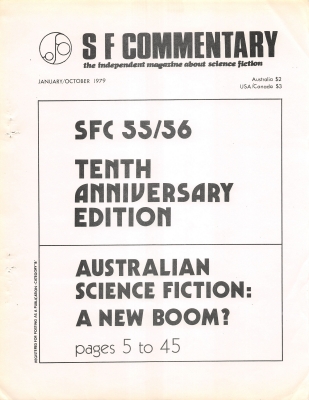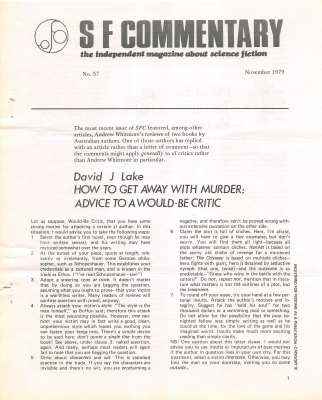The Golden Age of Science Fiction: SF Commentary, edited by Bruce Gillespie

The Ditmar Awards are named for Australian fan Martin James Ditmar Jenssen. Founded in 1969 as an award to be given by the Australian National Convention, during a discussion about the name for the award, Jenssen offered to pay for the award if it were named the Ditmar. His name was accepted and he wound up paying for the award for more years than he had planned. Ditmar would eventually win the Ditmar Award for best fan artist twice, once in 2002 and again in 2010. The Australian Fanzine Award was one of the Ditmar’s original awards and the first one was won by John Bangsund for Australian SF Review. Bruce Gillespie won his first Ditmar for SF Commentary in 1972 and the ‘zine also won the award in 1973, 1977, 1980, 2002, and 2018. He also won the award in 1986 and 1999 for his ‘zine Metaphysical Review and in 2010 for Steam Engine Time. Rich Horton took a look at SF Commentary as the winner of the 1973 Ditmar Award in his companion series looking at his own Golden Age of Science Fiction.
Bruce Gillespie began publishing SF Commentary in 1969 and by 1979 he was ready to publish issues 55 through 57, although the numbering a count was a little screwy. In January, he published a 68 page combination issue, numbered 55-56 and in November, he published the final issue of the year, 57, which came in at 16 pages.
Combined issue 55/56 opens with an editorial by Gillespie extolling the ten years that he has been publishing the fanzine. The article traces the history of the fanzine, and through it Australian fandom, through the ten years of its existence, including the ill-fated attempt in 1976 to turn the ‘zine into a semi-professional magazine. Toward the end of the article, Gillespie turns his attention away from the zine and fandom and discusses the major events and publications in science fiction over the course of the decade, along with a lengthy bibliography of stories published during that time that he would recommend. The article provides a lengthy and full view of the world of science fiction, as seen from Australia, from 1969 through the beginning of 1979. Gillespie summation of the decade runs for about a third of the article.
Of course, one of the key points of SF Commentary is to comment on science fiction, and the issue does include reviews. Sneja Gunew provides looks at George Turner’s Beloved Son immediately before Turner’s own essay on “Science Fiction in Australia,” which Gillespie describes as a shortened version of an article Turner had previously published in the English fanzine Arena, edited by Geoff Rippington. Turner goes back to Robert Potter’s 1892 novel The Germ Growers and traces the growth of Australian science fiction through the decades, hitting both low points and high points. His survey includes works that weren’t published in Australia, such as Ted Carnell’s magazine New Worlds, but does note that those magazines (and similar ilk) published the work of Australian speculative fiction authors.
More discussion and commentary are sprinkled throughout the issue, such as a discussion by Gillespie and Henry Gasko of Lee Harding’s Rooms of Paradise or Gillespie’s discussion of Turner’s The View from the Edge: A Workshop of Science Fiction Stories and Keith Antill’s Moon in the Ground. Given the length of the issue, there are several other book discussions filling the pages, some of which would be revisited in the following issue.
The discussions published in SF Commentary are more than reviews. They are, or attempt to be, critical examinations of the novels and non-fiction books the writers are reading, and often run the several pages in length. The in depth discussions of books provided a chance in the pre-internet era to really start a conversation about them and Gillespie’s active letter column permitted responses, not only by other readers, but often by the authors of the books being discussed. While this sort of discussion may still happen on the internet, the details in SF Commentary certainly can’t be summed up in the character limit of Twitter.

Issue 57 opens with an article by David J. Lake entitled “How to Get Away with Murder: Advice to a Would-be Critic.” This article was written as a response to a review of Lake’s novel Walkers on the Sky, written by Andrew Whitmore and published in issue 55-56. When Gillespie published the original review, he noted the review was “a thoroughly scurrilous and underhanded attack” on the reviewed novels, but also “the most entertaining articles I’ve published for years.” Lake responds to the attacks on his book with advice to the reviewer, pointing out that the use of wit and obfuscation, does not necessarily excuse a blatant attack.
As it happens, Gillespie also published a letter in this issue from Whitmore, thanking Gillespie for publishing the article and admitting that his review of Lee Harding’s Future Sanctuary “is a bit overdone,” but defending the review of Lake’s work as “every word that I have written there is true.” Whitmore’s letter, along with several of the other letters in the issue, congratulate Gillespie on his recent marriage. Whitmore’s letter is also followed immediately by a letter from Lee Harding. Although Harding notes that “apart from [Gillespie} and George Turner, there are not many genuine critical reviewers in Australia capable of dissecting an SF novel,” he “did find Andy Whitmore amusing…”
Following the letter column, Gillespie published Angus Taylor’s discussion of Barrington J. Bayley’s novel The Fall of Chronopolis, three reviews by Sneja Gunew of Damon Knight’s Turning Points: Essays on Science Fiction, Nebula Award Stories 11, and Vonda McIntyre’s The Exile Waiting, and a review by Van Ikin of Roger Zelazny’s Doorways in the Sand. Interestingly, for a fanzine published at the end of November 1979, most of the reviews are dated as having been written some time in 1977.
It took Gillespie a decade to publish his first 57 issues. Forty years later, Gillespie is still publishing SF Commentary and he published a two-party fiftieth anniversary edition, with part 1, issue 98, appearing in January and part 2, issue 99, appearing in July. The two parts taken together contain 164 pages. He is currently prepping part 3, issue 100, for publication in the near future.
Other fanzines nominated for the award in 1980 included Damian Brennan’s Bionic Rabbit, John Foyster’s Chunder, Jack Herman’s Forerunner, and Roy Ferguson’s The Wasffan. Chunder was the defending champion.
 Steven H Silver is a sixteen-time Hugo Award nominee and was the publisher of the Hugo-nominated fanzine Argentus as well as the editor and publisher of ISFiC Press for 8 years. He has also edited books for DAW, NESFA Press, and ZNB. He began publishing short fiction in 2008 and his most recently published story is “Webinar: Web Sites” in The Tangled Web. His most recent anthology, Alternate Peace was published in June. Steven has chaired the first Midwest Construction, Windycon three times, and the SFWA Nebula Conference 6 times, as well as serving as the Event Coordinator for SFWA. He was programming chair for Chicon 2000 and Vice Chair of Chicon 7.
Steven H Silver is a sixteen-time Hugo Award nominee and was the publisher of the Hugo-nominated fanzine Argentus as well as the editor and publisher of ISFiC Press for 8 years. He has also edited books for DAW, NESFA Press, and ZNB. He began publishing short fiction in 2008 and his most recently published story is “Webinar: Web Sites” in The Tangled Web. His most recent anthology, Alternate Peace was published in June. Steven has chaired the first Midwest Construction, Windycon three times, and the SFWA Nebula Conference 6 times, as well as serving as the Event Coordinator for SFWA. He was programming chair for Chicon 2000 and Vice Chair of Chicon 7.